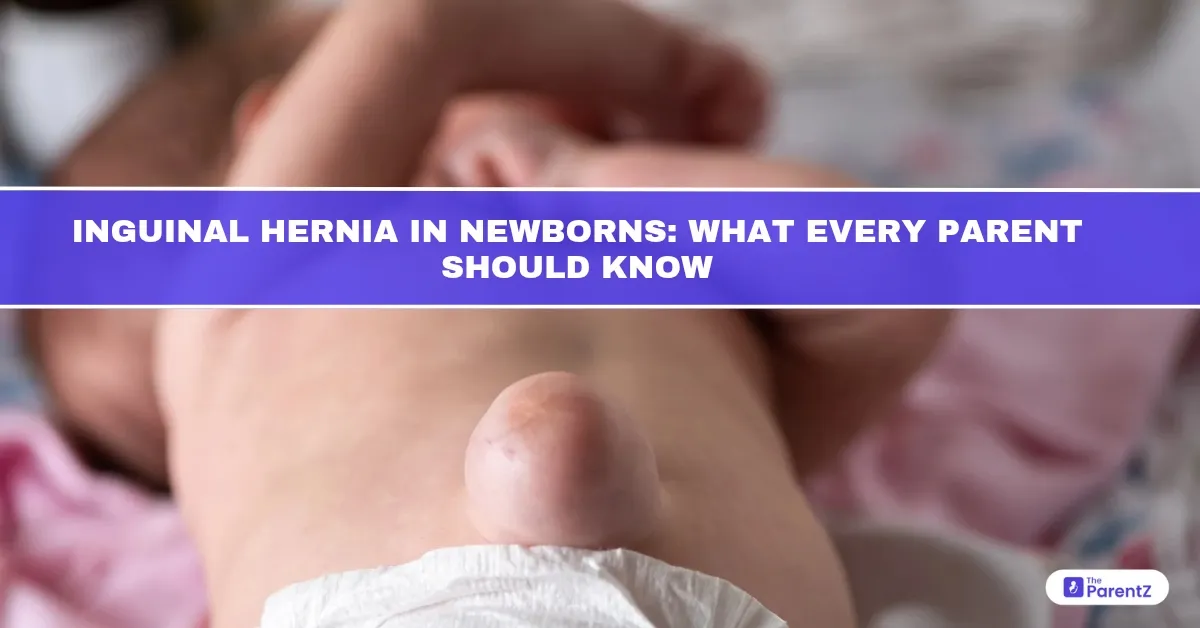As a parent, you may notice a small bulge in your baby’s groin or scrotum, especially when they cry or strain. It may seem harmless at first, but it could be a sign of an inguinal hernia, a common condition in newborns that deserves careful attention.
Though easily treatable with timely care, inguinal hernias in babies can lead to complications if ignored. Knowing the signs and understanding the underlying causes can help you take the right steps quickly and confidently.
What Is an Inguinal Hernia?
An inguinal hernia occurs when a part of the intestine or abdominal content pushes through a weak spot in the inguinal canal—a small passage in the lower abdominal wall near the groin.
In newborns, this usually presents as a soft bulge in the groin or scrotum, especially during crying, coughing, or straining. It may reduce (disappear) when the baby is calm or lying down.
Why Does It Happen in Newborns?
The inguinal canal plays a key role during fetal development. In male babies, the testicles descend through the inguinal canal into the scrotum before birth. In female babies, this canal also exists near the ovary and uterus.
Normally, the canal closes shortly before or after birth, but in some babies, it remains open. This open pathway allows abdominal content, like intestines, to slip through, forming a hernia.
Risk Factors Include:
- Premature birth (most common)
- Low birth weight
- Family history of hernias
- Male sex (inguinal hernias are 6–10 times more common in boys)
- Babies with conditions like cystic fibrosis, undescended testes, or connective tissue disorders
Recognising the Signs
Parents are often the first to notice something unusual. Here’s what to watch for:
Visible Signs:
- A bulge in the groin or scrotum (on one or both sides)
- Swelling that becomes more prominent when the baby cries, coughs, or strains
- Bulge disappears or becomes smaller when the baby is relaxed or lying down
Warning Signs (Seek Immediate Care):
- The bulge cannot be pushed back in (irreducible hernia)
- Redness, tenderness, or pain at the bulge site
- Baby is unusually irritable, vomiting, or refusing feeds
- Abdomen appears swollen or firm
- Signs of fever or distress
These symptoms may indicate a strangulated hernia—a surgical emergency where the herniated tissue is cut off from blood supply.
Types of Inguinal Hernia in Newborns
- Reducible Hernia
- Incarcerated Hernia
- Strangulated Hernia
Diagnosis: What Will the Doctor Do?
A pediatrician or pediatric surgeon will usually diagnose an inguinal hernia based on physical examination. They may observe:
- The size and behavior of the bulge
- Whether it is reducible
- The baby’s overall symptoms and discomfort
In rare cases, an ultrasound may be done to confirm the diagnosis or rule out other conditions like hydrocele, which can look similar but involves fluid instead of the intestine.
Treatment: Is Surgery Necessary?
Yes, surgical repair is the standard treatment for inguinal hernias in babies. Unlike in some adult hernias, this does not go away on its own and must be corrected to prevent complications.
Key Points About Surgery:
- Usually performed under general anesthesia
- Often a day-care procedure—discharge on the same or next day
- Small incision is made near the groin to close the hernia sac
- Quick recovery, with minimal pain
In bilateral hernias (both sides), both may be repaired in the same procedure.
What If the Baby Is Premature?
In preterm or medically fragile newborns, doctors may:
- Monitor the hernia closely for a few weeks
- Delay surgery until the baby gains enough weight or stabilizes
However, prompt surgery is needed if signs of incarceration or strangulation appear.
Post-Operative Care
After surgery:
- The baby may be fussy for a day or two
- Mild swelling near the incision is normal
- Keep the area clean and dry
- Follow your surgeon’s guidance on bathing, feeding, and medications
Most babies recover completely within a week, and the recurrence rate is very low with proper repair.
What’s the Difference Between Hernia and Hydrocele?
It’s easy to confuse an inguinal hernia with a hydrocele, especially in male babies.
| Feature | Inguinal Hernia | Hydrocele |
| Content | Intestine or fat | Fluid |
| Appearance | Bulge increases with crying | May remain unchanged |
| Reducibility | May be pushed back | Usually not reducible |
| Risk | Can strangulate | Usually harmless |
| Treatment | Needs surgery | May resolve on its own |
A medical examination helps clearly distinguish between the two.
Reassurance for Parents
Hearing the word “hernia” can cause panic, but rest assured:
- Inguinal hernia in newborns is very treatable
- Early diagnosis and surgery offer excellent outcomes
- Your baby will likely recover quickly and go on to live a healthy, active life
Conclusion: Timely Action, Lifelong Relief
An inguinal hernia in your newborn may feel frightening at first, but with prompt medical attention, it’s one of the most successfully treated surgical conditions in infants. As a parent, your awareness is the first and most powerful step in protecting your baby.
If you ever notice a groin bulge or suspect something unusual during crying or feeding, don’t wait; consult your pediatrician immediately. Sometimes, what looks small may be signaling a bigger need for care.
Let’s stay observant, informed, and gentle with our little ones because even the smallest signs can make the biggest difference.








Be the first one to comment on this story.